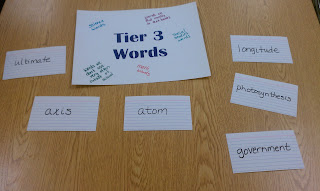 |
| Most of our words fit in tier one. In tier three, the words are very specialized. We tend to encounter them infrequently. Tier two words can show up in any class. They are words we use more often in writing to make our writing "juicy" or more specific. Tier two is general academic language as well; words like analyze, synthesize, defend. |
Can you tell from my graphic organizer that I decided to teach kids about the tiers of vocabulary? I began with the graphic organizer. Then I did an activity where I put Tier 1, Tier 2, and Tier 3 signs on three different tables (one sign per table.) I put a bunch of words on index cards, handed them out to the kids and telling them to go to it. I let them decide if they wanted to work alone or talk to others. Here's what the activity looked like:
 |
| Grade 6 girls debate whether a word should go on the Tier 2 table. |
 |
| The words the students put in Tier 3. |
After this activity, we were ready to apply our new knowledge to a piece of reading. I chose an article from Dig magazine called The Mysteries of Ancient Poop. Cuz, seriously, what sixth grader doesn't want to read about poop!? The students really focused on vocabulary, pulling out Tier 3 words like archaeologist and coprolite (the scientific name for ancient poop!) and Tier 2 words like excavate and comparison. Their thinking was deep, their discussions about words were heated but respectful. It was so fun to watch them!
The students have realized the importance of focusing on Tier 2 words. They see that they are often harder to understand because they are often abstract words, while Tier 3 words are often long and hard to pronounce but represent concrete things. So next week, we will take some of their Tier 2 words and start to talk about context clues and what strategies we can use to figure out what these words mean.
It is so amazing to see their interest in words grow. To see them work with joy and excitement to analyze and talk about words. I can't wait to see what they figure out next!
ADDENDUM: Thinking about these vocabulary activities with a lens of formative assessment and triangulation of data (gathering student evidence through conferences, observations, and products) I was cognizant of being aware of the understanding of every student. The sorting activity allowed me to make great observations. I looked for evidence of understanding or confusion in their faces and body language. When I saw a student wavering between Tiers but working alone, I conferred with that student, asking questions like, "What are you thinking about that word?" or "What might be making you lean toward Tier 2?" And during the debrief when we all stood around tables, each student had the opportunity to explain the placement of a word. Their classmates listened and asked questions or made arguments to push their thinking, giving lots of peer feedback. Who needs summative assessments when you can gather all the evidence of success that you need formatively? :)
Great!!
ReplyDeletei love this type blog very much which help new generation to getting education...
vocabulary flashcards
TOEIC vocabulary flashcards